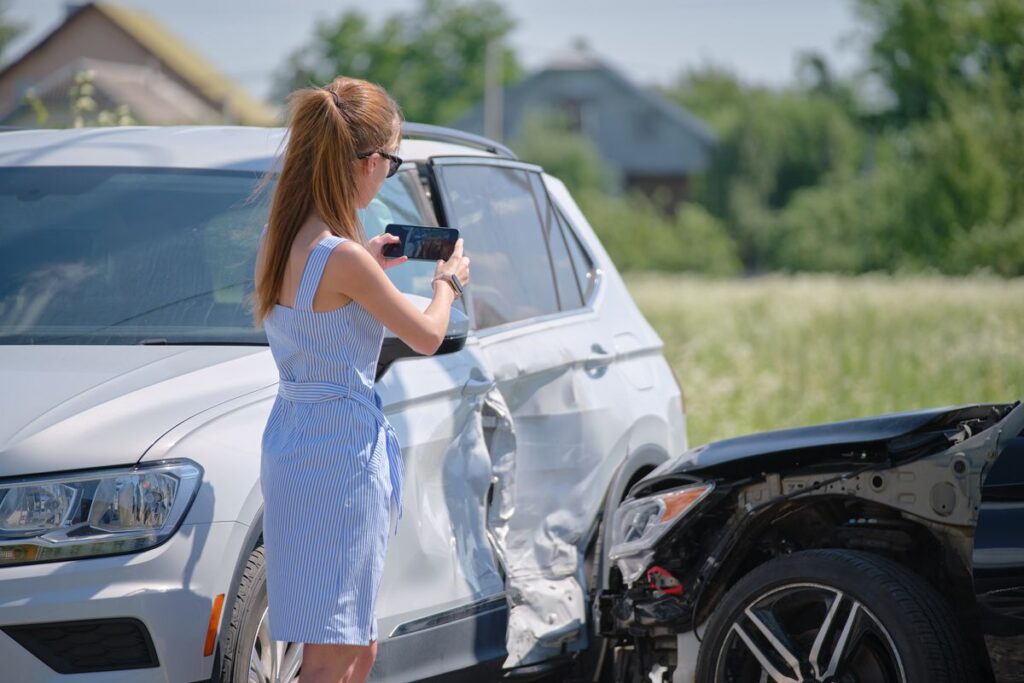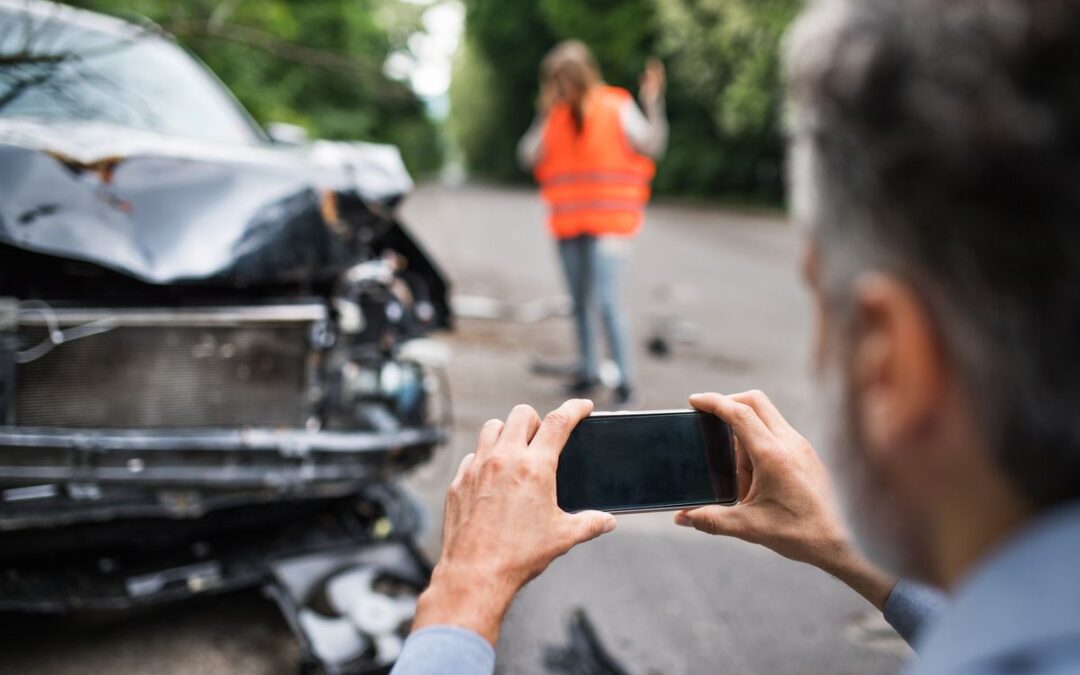In the realm of personal injury claims in Georgia, the adage “a picture is worth a thousand words” holds particularly true. Accident scene photos can significantly impact the outcome of a personal injury claim. This blog looks into why these photos are crucial and how to effectively capture and use them in your claim.
The Role of Photos in Personal Injury Claims
In the intricate process of personal injury claims in Georgia, photos from the accident scene are more than just snapshots; they are compelling pieces of evidence. These images capture moments frozen in time, providing a clear, visual account of the incident that mere descriptions cannot match. In the legal landscape of Georgia, where establishing fault is a critical component of a personal injury claim, these photos often play a pivotal role.
When you present photos showing the aftermath of an accident, you provide tangible proof of the circumstances surrounding the event. This can include the positioning of vehicles, the extent of damage, environmental conditions, and any hazards that might have contributed to the accident. Such details, when captured visually, can speak volumes, often more effectively than a verbal or written testimony.
Moreover, in Georgia, where the legal system operates on the principle of comparative negligence, establishing the degree of fault is crucial. Photos can directly influence this determination. They can demonstrate factors like the angle of a collision, the impact points on vehicles, or the presence of tire marks, all of which are critical in reconstructing the accident and determining who was at fault.
Capturing the Accident Scene
Immediately after an accident, if you’re able to do so safely, start taking photos. Capture different angles of the vehicles, any visible injuries, and the surrounding area. These images will help to establish the context of the accident, showing road conditions, traffic signs, and the positioning of vehicles.
Documenting Vehicle Damage
In the aftermath of a car accident in Georgia, documenting vehicle damage through photos is a critical step in your personal injury claim. These images serve as concrete evidence, illustrating the impact and severity of the collision. When you capture detailed photos of all vehicles involved, you create a visual record that can be pivotal in proving the extent of the accident and supporting your claim.
Close-up shots are essential for highlighting specific areas of damage. They can show the depth of dents, the pattern of paint scratches, or the shattering of glass, providing insights into the collision’s force and direction. These details are crucial in establishing the accident’s dynamics and can be instrumental in proving how the impact occurred and the likely injuries resulting from it.
Wider-angle shots are equally important as they place the damage within the context of the entire vehicle and the accident scene. They offer a broader perspective, showing the overall condition of the vehicles and their position on the road. This comprehensive view can help in correlating the damage to the vehicles with the injuries you claim, demonstrating how the impact could have caused your specific injuries.
Recording Road Conditions
Road conditions can significantly influence the outcome of an accident. Photos that capture the state of the road, weather conditions, and any potential hazards can be pivotal. They provide insight into factors that might have contributed to the accident, such as slippery roads or obscured traffic signs.
Showcasing Traffic Signs and Signals
Photographs of traffic signs and signals near the accident scene can establish crucial details about right of way and traffic rules that may have been violated. This evidence is particularly important in Georgia, where traffic laws play a significant role in determining fault in personal injury claims.

Highlighting Injuries
Capturing photographic evidence of your injuries immediately after a car accident is a critical step in your personal injury claim in Georgia. These initial images serve as powerful, undeniable evidence of the accident’s impact on your body. When taking these photos, focus on clarity and detail. Capture various angles and close-ups of each injury to provide a comprehensive view.
It’s equally important to document the progression of your injuries over time. Follow-up photos can illustrate the healing process, the severity and duration of bruising, swelling, cuts, or any other physical damage. This ongoing documentation is crucial, as it provides a visual timeline of your recovery, which can be particularly persuasive in personal injury cases.
Moreover, these photos can help in correlating the injuries with the specifics of the accident. For instance, seat belt marks can indicate the force of the impact, while certain types of injuries might align with your account of how the accident occurred. This correlation can be a significant factor in establishing the other party’s liability.
Importance of Time and Date Stamps
Ensure your camera or smartphone captures the time and date on each photo. This information can validate the timing of the accident and the immediacy of the photos taken, adding to their credibility as evidence.
Utilizing Witnesses
If there are witnesses, consider asking them to take photos as well. Different perspectives can provide a more comprehensive understanding of the accident scene. Witness photos can also serve as additional evidence to support your claim.
Legal Considerations for Using Photos
In Georgia, the legal system places significant weight on evidence. Photos used in personal injury claims must be relevant, authentic, and obtained legally. Understanding how to present these photos in your claim is key to their effectiveness.
Organizing and Storing Photos
After capturing the necessary photos, organize and store them safely. Create backups of these images, as losing them can be detrimental to your case. Label each photo with a description and the date it was taken. This organization will be invaluable when you need to retrieve specific images quickly during the legal process.
Communicating with Your Attorney
Share your accident scene photos with your attorney at Rebecca Kay Sapp Law Firm as soon as possible. An experienced personal injury lawyer at our firm can analyze these images to build a stronger case. They can also advise you if additional photos or evidence are needed. Your attorney will know how to effectively incorporate these photos into your legal strategy.

Photos as a Tool for Negotiation
Leveraging accident scene photos during settlement negotiations can significantly influence the outcome of your personal injury claim in Georgia. These photos serve as irrefutable evidence, often compelling insurance companies to offer a fairer settlement. When you present clear, well-documented images showing the extent of the damage and the circumstances of the accident, you essentially strengthen your negotiating position.
Insurance adjusters often scrutinize claims to identify inconsistencies or exaggerations. However, photos provide a factual basis that is hard to dispute. They can clearly depict the severity of the collision, the damages to the vehicles involved, and any injuries sustained. This visual evidence can validate your claims about the accident and its impact, making it challenging for insurance companies to downplay the severity of the incident.
Moreover, detailed photos can help in quantifying the damages. For instance, images showing extensive vehicle damage or serious physical injuries can justify higher compensation amounts for repairs, medical expenses, and pain and suffering. They can also be used to challenge any discrepancies in the insurance company’s assessment of the damages.
Avoiding Common Mistakes
When taking accident scene photos, avoid common mistakes. Ensure the photos are clear and in focus. Don’t alter or manipulate the images, as this can undermine their credibility. Also, be mindful of privacy concerns and legal boundaries when photographing individuals or private property.
Conclusion
In conclusion, accident scene photos are a critical element in personal injury claims in Georgia. They provide undeniable evidence that can strengthen your case, influence negotiations, and sway jury opinions. Remember, in the aftermath of an accident, your smartphone is more than just a communication device – it’s a tool for justice.

